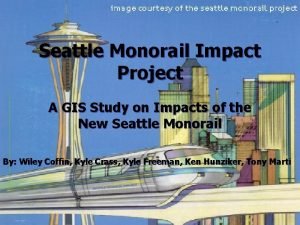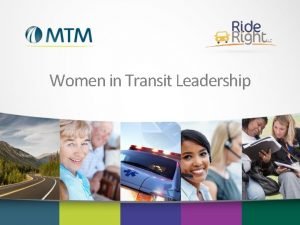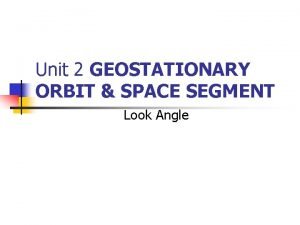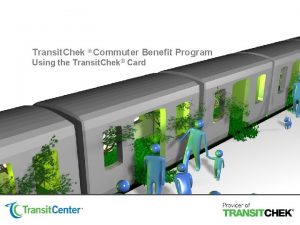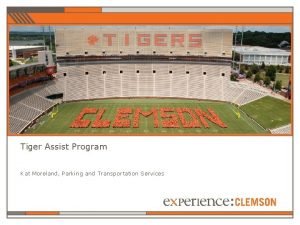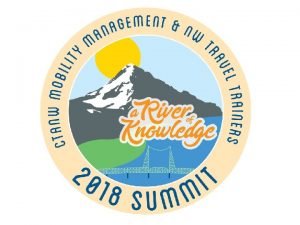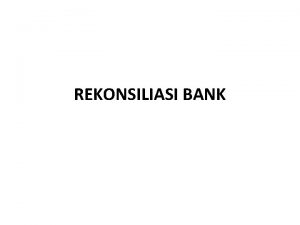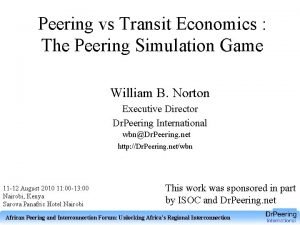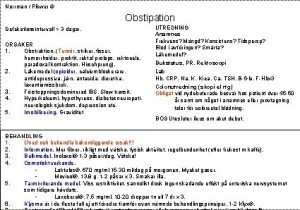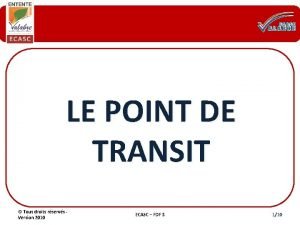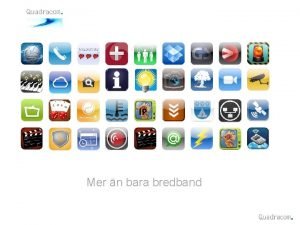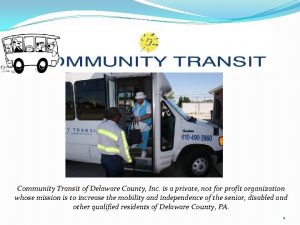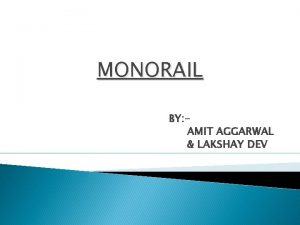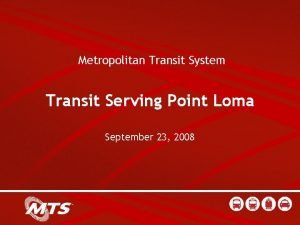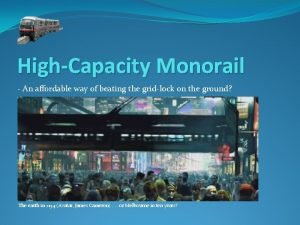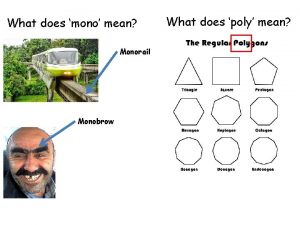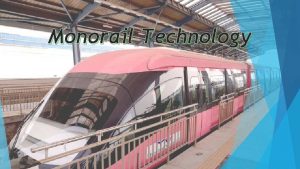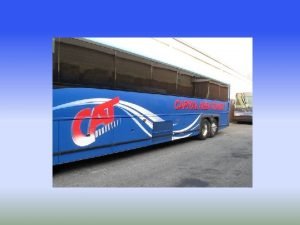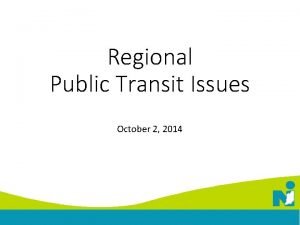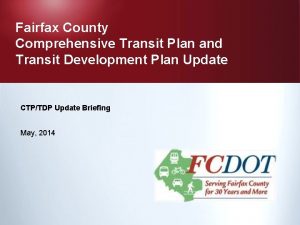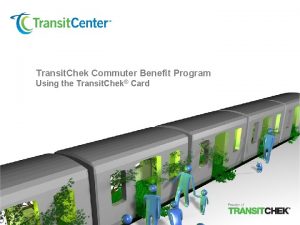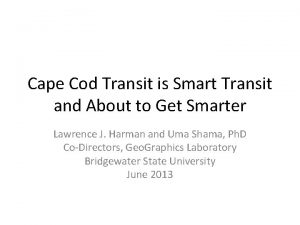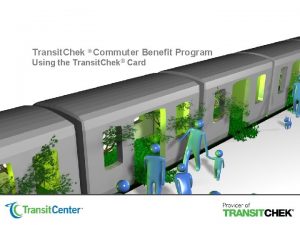Monorail The monorail is a transit system that






















- Slides: 22


Monorail • The monorail is a transit system that sues a single rail. • In some systems the monorail cars ride on top of the trail. • In others systems the monorail hangs from the rail.

Automated Transit system (ATS) • ATS systems are used at large facilities such as airports, shopping centers, remote parking areas, and hospitals. • These systems do not need drivers to operate. • Ex: • Maglev Trains • Automated Transit Systems of the future: • Self Driving Car • Bigger Picture?

Magnetic Levitation Trains • Maglev trains operate on the principle that likes poles of a magnet repel one another. • Magnets in the maglev track repel magnets of like polarity on the bottom of the train. • This action causes the train to levitate (rise) about 4 inches above the track to create a nearly frictionless riding surface. • Because there is little friction, the train can be accelerated easily to speeds of 300 -400 MPH • . An advantage of Maglev Trains is that it used less energy and the roadbed receives little wear. Also, no emissions are released into the air • Maglev Trains

Buses • The bus was developed to transport large numbers of people within large cities. • City Buses are stull used for this purpose. • Today buses are used in many ways: • School buses are used to transport students to and from school • Motor coaches are used to transport people to and from suburbs and inner cities. They are also used for long distance transportation. • Motor coaches can also be rented by an individual or group of people to provide transportation to places such a historical sites, museums, and state and national parks.

Automobiles • • • In the US the automobile has become a major part of our way of life. Only 6% of the earth’s population lives in the US. However, over 50% of all the automobiles in the world are used in the US. Automobiles have over 10, 000 parts. Types of Automobiles • Coupes- small, usually two door cars, some are often termed sports cars • Sedans- larger than coupes, usually have 4 doors • Sport-utility vehicles (SUV)- raised like pickups, and include comforts you find in a sedan • Vans- built to hold more cargo and passengers then other automobiles • Pickup trucks- sit taller than most automobiles and have an open bed An automobile may be thought of as having the following basic components: • Body • Suspension system • Power system • Control system

Body • The Body of an automobile is its most visible part. • When we think a car is nice-looking, we are reacting to the appearance of the body. • The car body is not just for looks, it must be comfortably enclose the vehicle. • The body must be weather-tight and strong. • It must provide the passengers with comfort and safety.

Suspension system • The Suspension System of an automobile connects the car’s body to the axles and wheels to provide an even, smooth ride. Frame the automobile • Without suspension, Upperwould Control Armhave a very uncomfortable ride and would have poor traction at high speeds. Shock Absorbers Lower Control Arm Coil Spring

Power system • The Power System of an automobile consists of an engine and a drive train. • Automobiles are propelled by an engine and a drive train. The engine supplies the power and the drive train transmits it to the car’s wheels. • Most automobiles engines are of a four-cycle, internal combustion type. • The drive train may be either rear- or frontwheel drive. • A transmission is used to control the power and speed developed by the engine.

Control system • The Control System consists primarily of a steering and breaking system. • The Steering System: • Provided directional control • Connects the front wheels of the automobile to a steering wheel. • The Braking System: • Stops the automobile • When the brake pedal is pushed, friction is produced at each wheel. • The friction converts the kinetic energy of the moving vehicle into heat energy.

Steering system BRAKING SYSTEM

Trucks • Trucks transport large amounts of cargo. • The advantage of trucks is that they can go directly from the maker of the product to the locations where the product will be sold or used. • There are many types of trucks: • • • Tractor-trailer trucks Dump trucks Delivery trucks Ice-cream trucks Garbage trucks Cement trucks

Tractor-trailer trucks • Tractor-trailers are the “big rigs” of the highway. • Tractor-trailer trucks are most often found on our highways. These trucks consist of • a large tractor, which is the power plant of the truck • A trailer, which carries the cargo. • Trailers are designed for many purposes: • Box trailers carry freight such as canned goods, electronic equipment, furniture, and many other products. • Refrigerated trailers transport perishable food items such as lettuce and meat. • Other trailers consist of glass-lined or metal-lined tanks for transporting liquids such as milk and even molten chocolate.

Fifth wheel • A truck’s tractor connects to the trailer with a fifth wheel. • The Fifth Wheel is the large, disk-shaped hitch that is located at the rear of the tractor. • It is in the same on almost all tractors, which allows the trailer to be pulled by almost any tractor.

Types of intermodal transportation • Piggyback • Trucks and rail • Fishyback • Water and trucks • Trainship • Water and rail • Airship • Air and water

Piggyback • Truck trailers can also be transported by train with a method called Trailer on Flatcar (TOFC) commonly referred to as Piggyback. • In this method, truck trailers are loaded with cargo and then driven by truck to a terminal. • At the terminal the trailers are loaded onto railroad flatcars. • The trailers are then carried by train to the terminal closest to their final destination. • From the final destination terminal, the trailers are driven the final distance by other trucks.

Fishyback • Using a method similar to piggyback, truck trailers can also be transported on ships. • This method is called Fishyback. • Combing modes of transportation in this way saves both fuel and labor

Motorcycles • Although motorcycles are used mainly for pleasure, many Americans use motorcycles each day to commute to and form work. • Categorized into 2 categories: • Street: cruiser, sport, touring • Off- road: dirt bike • Motorcycles use less gasoline than automobiles, are easier to park, and cause little or no traffic congestion. • Disadvantages are that they are: • less comfortable than automobiles • can be dangerous, especially in bad weather • Can not carry very much material

Roadways • Railroad Roadways • • Consist of railroad tracks and various yards and terminals designed to control the flow and makeup of the trains. Railroad beds are made of: • Ballast, crossties, rail plates, and spikes • Interstate Highways • • • Make up a federal road systems that connects 90% of the larger cities in the US Interstate Highways are a controlled access road system. This means that drivers can enter or leave the highway only at certain places. These points of access are specifically designed ramps. • Other Highways and Streets • • A system of US Highways crosses from one state to another State Highways link towns and cities within each state. Most highways are free to use. • • In some states, Toll Roads or Turnpikes have tolls that charge a fee. The money collected is used to pay for the construction and the maintenance of the highway. Streets are designed for city traffic • • City planners identify streets with names, numbers, or letters. This information, plus numbers given to houses and other buildings, make it possible to find a certain address.

Highway construction • The construction of modern highways can either be rigid or flexible. • Rigid Highway Construction: • Steel bars are set on a sand base, concrete is then poured over the bars to a depth of about 8 inches. • This rigid slab is strong enough and stiff enough to spread the heavy loads of the traffic over a large area. • Interstate highways are made using rigid highway construction. • Flexible Highway Construction: • Thick gravel subbase is prepared first, then a concrete base is added and lastly, a final coating of hot mix asphalt finishes the highway. • This flexible surface resists damage because it gives slightly under heavy loads. • With flexible highways, the subbase, rather than the top coating, spreads the load into the soil underneath.

Roadway regulation and control • Train traffic is regulated by automatic lights, signals, switches, and other controls. • Different colored lights are used to tell the engineer what conditions lie ahead, what speed it is safe to travel, and if there is another train on the track ahead. • Traffic on highways is controlled by traffic lights and traffic signals. • • • Many cities have central, computer-controlled traffic light systems. The computers are programed to regulate the timing of the traffic lights. As traffic conditions change, the central computers change the timing of the lights. This way, traffic is kept moving as smoothly as possible. • Road signs and markings on streets are still other forms of roadway regulation and control. • • Speed limit signs, for example, are designed to keep vehicles moving at safe speeds. Markings on the street, such as crosswalks and lane-dividing lines, help to keep vehicles in the proper areas of the road. • Some traffic lights are equipped with light-sensitive devices that can be activated by ambulances and fire trucks. • When activated, the device turns the light to green in the direction the emergency vehicle is traveling.

Future land transportation systems • At the present time almost all land transportation vehicles use either diesel fuel or gasoline. • Both of these fuels are made from petroleum, unfortunately, petroleum supplies are limited. • One way of conserving energy is to use vehicles that use less fuel or a nonpetroleum-based fuels. • Future systems include: • Advanced Passenger Train-Experimental (APT-E) • • • Twin-engine Car • • • The train has an aerodynamic design and uses a gas turbine engine for propulsion. The turbine can propel the train at speeds of approximately 150 MPH. Twin-engine cars use a gas engine for starting and accelerating, and a battery-powered electric motor for cruising. The battery is designed so that is can be replaced quickly without much effort. Solar cells in the roof power small internal systems such as the radio. For improved gas mileage, the car is made from light materials such as plastic, aluminum, and ceramic. The Lean Machine • • 3 feet wide, 4 feet high, and 10 feet long, and weighing 400 pounds, this three-wheeled, one-passenger vehicle combines the characteristics of an automobile and a motorcycle. It can reach 60 MPH in seven seconds and can achieve 200 miles on a gallon of gas.
 Seattle monorail route
Seattle monorail route Phân độ lown
Phân độ lown Block nhĩ thất độ 2 mobitz 2
Block nhĩ thất độ 2 mobitz 2 Thơ thất ngôn tứ tuyệt đường luật
Thơ thất ngôn tứ tuyệt đường luật Thơ thất ngôn tứ tuyệt đường luật
Thơ thất ngôn tứ tuyệt đường luật Walmart thất bại ở nhật
Walmart thất bại ở nhật Tìm vết của đường thẳng
Tìm vết của đường thẳng Hãy nói thật ít để làm được nhiều
Hãy nói thật ít để làm được nhiều Tôn thất thuyết là ai
Tôn thất thuyết là ai Gây tê cơ vuông thắt lưng
Gây tê cơ vuông thắt lưng Sau thất bại ở hồ điển triệt
Sau thất bại ở hồ điển triệt Mtm transit and capital metro
Mtm transit and capital metro Sun transit outage
Sun transit outage Tccard.transit center
Tccard.transit center Tiger transit clemson
Tiger transit clemson Pierce transit logo
Pierce transit logo Pengertian deposit in transit
Pengertian deposit in transit Pengertian deposit in transit
Pengertian deposit in transit Peering vs transit
Peering vs transit Slow transit förstoppning
Slow transit förstoppning Point de transit pompier
Point de transit pompier Transit bredband
Transit bredband Delaware county community transit
Delaware county community transit
